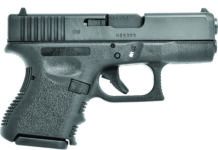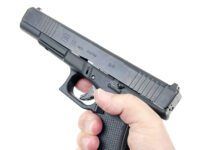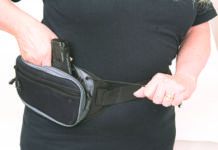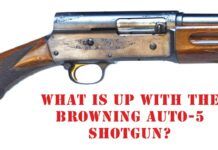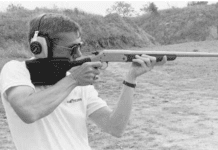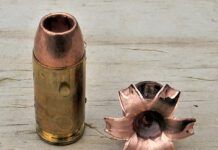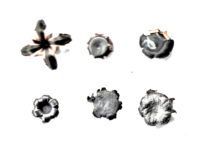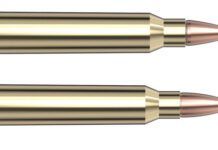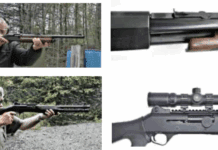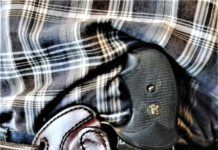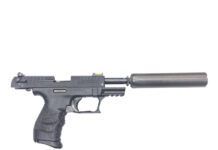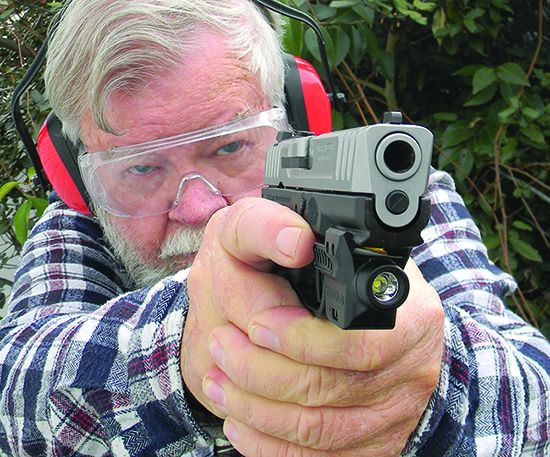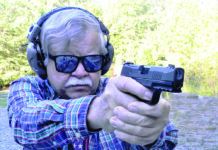In this time of inflation, with salaries not expanding as quickly as prices, it’s tempting to postpone getting the tools needed for self defense. Yet, we wish to be as well armed as possible. The modern striker-fired polymer-frame 9mm is the default defensive handgun these days, yet with many approaching $700 or more, folks on tight budgets are sometimes left out. So we decided to test two affordable 9mm handguns and give them the usual Gun Tests work up. One was a new addition, the Smith & Wesson SD9 2.0, which features a slight redesign and a much better new blade-type trigger. Against this pistol we matched a SAR9 Mete Safari 9mm from the Turkish maker Sarsilmaz. While each pistol fills the bill for personal defense, we found one has more advanced features.
Smith & Wesson SD9 2.0 13931 9mm Luger
$300
Gun Tests grade: B
The S&W SD9 update is a nice addition to this affordable family of striker handguns. There are things the pistol lacks, including grip inserts and slide panel inserts. However, the SD9 is reliable, useful, and accurate enough for personal defense.
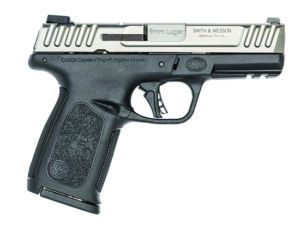
| Action Type | Striker fired |
| Overall Length | 7.2 in. |
| Overall Height | 5.5 in. |
| Maximum Width | 1.3 in. |
| Weight Unloaded | 23.0 oz. |
| Weight Loaded | 29.6 oz. |
| Slide | Matte stainless steel |
| Slide Retraction Effort | 16.4 lbs. |
| Receiver | Black polymer |
| Front Strap Height | 2.5 in. |
| Rear Strap Height | 3.1 in. |
| Barrel Length | 4.0 in. |
| Grip Thickness Maximum | 1.2 in. |
| Grip Circumference Maximum | 5.6 in. |
| Magazines | (1) 16 round |
| Rear Sight | Drift adjustable |
| Front Sight | White outline |
| Sight Radius | 6.0 in. |
| Trigger Pull Weight | 6.0 lbs. |
| Trigger Span | 2.7 in. |
| Safeties | Striker block and trigger lever |
| Warranty | 1 year |
| Telephone | (800) 331-0852 |
| Website | Smith-Wesson.com |
| Made In | U.S. |
We purchased our test gun at an Academy Sports store on sale for $300. That is affordable, but a local shop had one the next day for $325 with two magazines, while ours had a single magazine in the cardboard box along with a manual and gun lock. Even better, we located an SD9 with two magazines and a Crimson Trace combat light on line for $350. So shop around.
The SD9 2.0 is a new development on an older handgun. The slide is redesigned with a different angle in the cocking serrations. The pistol features three-dot sights, with the front sight nicely dovetailed in place, in contrast to the usual screwed-on sight so common today. The pistol features a groove down most of the length of the slide, a touch reminiscent of the Smith & Wesson 5906. The cocking serrations are well designed and offered plenty of leverage. The grip frame does not feature grip inserts. The grip is nicely pebbled and offers a good balance of abrasion and adhesion.
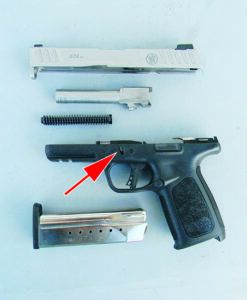
While measurements indicate the S&W and SAR9 handles are very close in dimensions, the S&W feels smaller. The Smith & Wesson SD9 does not feature finger grooves. The grip treatment and design are well done. The steel magazines are not difficult to load. The magazine features a 16-round capacity, one short of the SAR9’s. The S&W magazine was easy to load to full capacity.
The big news is the new trigger. A few years ago, Smith & Wesson upgraded the Military & Police 2.0 pistol with a blade-style trigger, replacing the bifurcated type of the earlier pistols. The result is greater control and a sharper let off. The 2.0’s trigger action is now transferred to the SD9. The trigger features a blade-type safety lever. Trigger compression is smooth and the reset sharp. We like this trigger very much.
It would have been good as well if Smith & Wesson had redesigned the SD9 for compatibility with M&P magazines, especially in light of the recently introduced S&W carbines. Just the same, magazines for the SD9 are not difficult to find.
The manual of arms of the SD9 is the same as the SAR, save for the SAR9 featuring a manual safety. We fired the pistol on a combat course in the same manner as the SAR9, with the same ammunition. Results were good. The SD9 is 4.9 ounces lighter than the SAR9. Recoil seems greater, which is a matter of physics. The SD9’s recoil is a trade off with its lighter carry weight. The difference isn’t enough to make the pistol a chore to fire; it is as comfortable as a Glock 19 we had on hand for comparison. The pistol is a good combat shooter. Combat firing was fast, and combat groups were good. The SD9 didn’t quite have the groups of the SAR9, but it wasn’t difficult to manage at all.
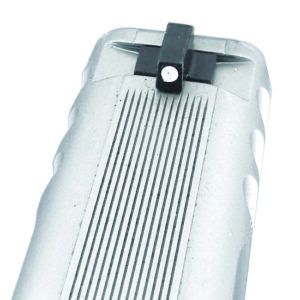
During the firing stage and in performing speed loads, we compared the pistol’s features. The SAR9 features a longer magazine release that responded well to a press rather than a punch. The SAR9’s slide lock is smaller, but each was comfortable during firing and each allowed rapid speed loads. Tapered magazines and nice-sized magazine wells made for good speed during reloads, with the SAR9 being slightly faster in overall speed. As for left-hand use, the pistols are typical striker-fired types. Draw and fire, no problem there.
The SAR9 features an ambidextrous safety lever the SD9 lacked. Each pistol features a single slide lock. The magazine release is easily hit with the left-hand forefinger, but the SD9 has a protected edge. In the end, either pistol may be used by a left-handed person, but neither gun is ideally suited to lefty shooters.
Our Team Said: The SD9 2.0 is accurate enough for personal defense, with some groups in the 3-inch range and some larger. The pistol never failed to feed, chamber, fire, or eject. We rated the pistol down a half grade on accuracy and another half grade on the trigger action. One rater suggested rating the SD9 down for its lack of grip inserts, but we did not, considering the price.
| 9MM LUGER RANGE DATA | ||
| Federal Syntech 147-grain TSJ | Smith & Wesson SD9 2.0 | Sarsilmaz SAR9 Mete |
| Average Velocity | 923 fps | 941 fps |
| Muzzle Energy | 278 ft.-lbs. | 289 ft.-lbs. |
| Small Group | 2.6 in. | 2.5 in. |
| Average Group | 3.4 in. | 3.2 in. |
| Black Hills 124-grain JHP | Smith & Wesson SD9 2.0 | Sarsilmaz SAR9 Mete |
| Average Velocity | 1120 fps | 1144 fps |
| Muzzle Energy | 348 ft.-lbs. | 363 ft.-lbs. |
| Small Group | 2.5 in. | 2.4 in. |
| Average Group | 3.3 in. | 2.9 in. |
| Hornady Critical Defense 115-grain FTX 90250 | Smith & Wesson SD9 2.0 | Sarsilmaz SAR9 Mete |
| Average Velocity | 1107 fps | 1150 fps |
| Muzzle Energy | 313 ft.-lbs. | 338 ft.-lbs. |
| Small Group | 2.6 in. | 2.0 in. |
| Average Group | 3.3 in. | 2.5 in. |
We fired groups at 25 yards from a benchrest position using an MTM Case-Gard K-Zone Shooting Rest. We used a Competition Electronics Pro Chrony to measure muzzle velocities. Notes: JHP = jacketed hollow point. TSJ = Total Synthetic Jacket. FTX = Flex Tip.
Written and photographed by Gun Tests Staff, using evaluations from Gun Tests Team members. GT


